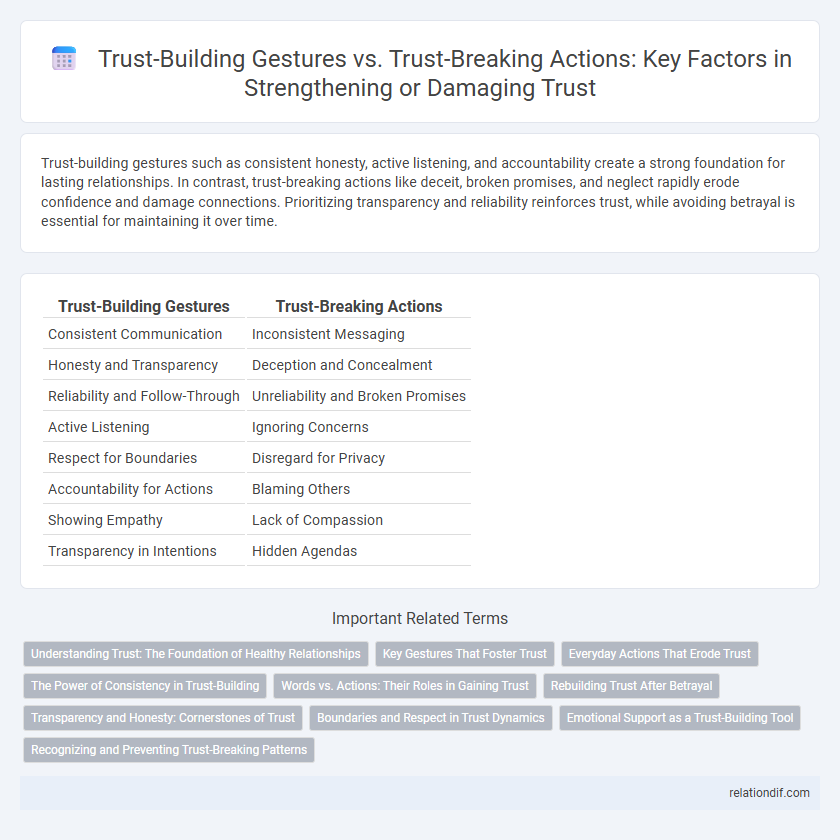Trust-building gestures such as consistent honesty, active listening, and accountability create a strong foundation for lasting relationships. In contrast, trust-breaking actions like deceit, broken promises, and neglect rapidly erode confidence and damage connections. Prioritizing transparency and reliability reinforces trust, while avoiding betrayal is essential for maintaining it over time.
Table of Comparison
| Trust-Building Gestures | Trust-Breaking Actions |
|---|---|
| Consistent Communication | Inconsistent Messaging |
| Honesty and Transparency | Deception and Concealment |
| Reliability and Follow-Through | Unreliability and Broken Promises |
| Active Listening | Ignoring Concerns |
| Respect for Boundaries | Disregard for Privacy |
| Accountability for Actions | Blaming Others |
| Showing Empathy | Lack of Compassion |
| Transparency in Intentions | Hidden Agendas |
Understanding Trust: The Foundation of Healthy Relationships
Trust-building gestures such as active listening, consistent honesty, and reliable follow-through establish a solid foundation for healthy relationships by fostering emotional safety and mutual respect. Trust-breaking actions like dishonesty, neglect, and betrayal disrupt this foundation, causing emotional harm and eroding connection. Understanding trust as the core element in relationships highlights the critical role these behaviors play in maintaining or damaging interpersonal bonds.
Key Gestures That Foster Trust
Consistent transparency, active listening, and follow-through on promises are key gestures that foster trust in relationships. Demonstrating empathy and acknowledging others' perspectives reinforce reliability and emotional safety. Regularly providing constructive feedback and maintaining confidentiality further establish a foundation of trustworthiness.
Everyday Actions That Erode Trust
Everyday actions that erode trust include consistently missing deadlines, failing to communicate openly, and breaking promises, as these behaviors signal unreliability and dishonesty. Small gestures like dismissive body language or neglecting to acknowledge others' contributions can slowly degrade trust in personal and professional relationships. Recognizing and addressing these trust-breaking actions early is crucial to maintaining a foundation of mutual respect and confidence.
The Power of Consistency in Trust-Building
Trust-building gestures thrive on consistent actions that reliably meet expectations, reinforcing confidence over time. In contrast, trust-breaking actions often stem from unpredictable behavior that undermines credibility and creates doubt. The power of consistency lies in establishing a dependable pattern that fosters long-term trust and solidifies relationships.
Words vs. Actions: Their Roles in Gaining Trust
Words set the foundation for trust by conveying intentions and values, but consistent actions validate those promises and solidify confidence. Trust-building gestures such as honest communication and follow-through demonstrate reliability, while trust-breaking actions like deceit or inconsistency quickly erode credibility. Effective trust development hinges on aligning spoken commitments with transparent, dependable behaviors.
Rebuilding Trust After Betrayal
Rebuilding trust after betrayal requires consistent trust-building gestures such as transparency, accountability, and active listening to address the emotional impact of broken trust. Trust-breaking actions like deceit, inconsistency, or neglect severely damage relationships, necessitating deliberate efforts to demonstrate reliability and empathy over time. Effective rebuilding hinges on prioritizing honest communication and patience to restore confidence and repair the relational foundation.
Transparency and Honesty: Cornerstones of Trust
Transparency and honesty serve as the foundation for trust-building gestures, fostering open communication and reliability. Consistently sharing accurate information and admitting mistakes create a culture of accountability, strengthening relationships. Conversely, withholding information or deceitful behavior are trust-breaking actions that erode confidence and damage reputations.
Boundaries and Respect in Trust Dynamics
Setting clear boundaries and demonstrating respect are fundamental trust-building gestures that reinforce stability and predictability in relationships. Violations of personal boundaries or disrespectful behavior act as trust-breaking actions, eroding confidence and creating emotional distance. Consistent acknowledgment of limits and respectful communication nurture trust dynamics, promoting mutual understanding and long-term connection.
Emotional Support as a Trust-Building Tool
Emotional support fosters trust by demonstrating empathy, active listening, and consistent reassurance during vulnerable moments. Trust-building gestures such as validating feelings and providing comfort enhance relational security and deepen connection. In contrast, trust-breaking actions often involve neglecting emotional needs, dismissing concerns, or showing indifference, which erode trust and create distance.
Recognizing and Preventing Trust-Breaking Patterns
Trust-building gestures such as consistent communication, transparency, and active listening strengthen relationships by fostering reliability and openness. Recognizing trust-breaking actions like deceit, broken promises, and evasive behavior is crucial to prevent damage and restore confidence. Implementing early intervention strategies and promoting accountability helps identify and stop trust-breaking patterns before they erode foundational bonds.
Trust-building gestures vs Trust-breaking actions Infographic

 relationdif.com
relationdif.com